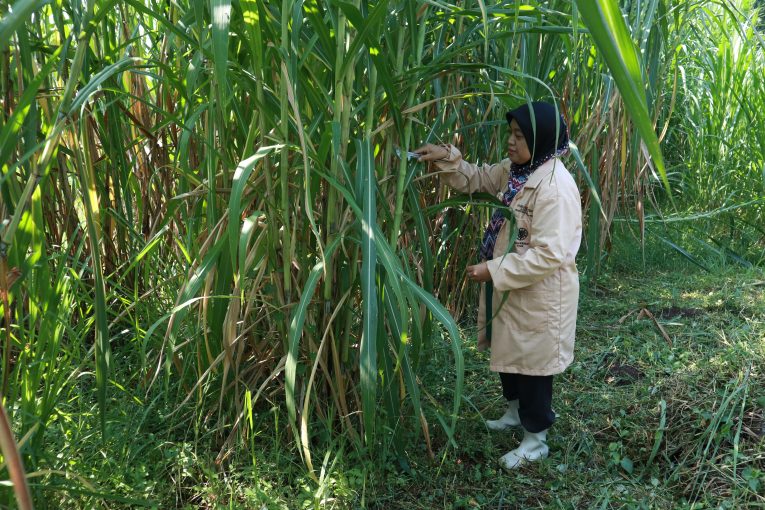
The Faculty of Animal Science (FAS) UGM has developed Gama Umami grass, which is a mutation of elephant grass that has been irradiated with gamma rays to produce grass that is superior to its parents. Elephant grass was chosen because it is a superior type, favored by ruminants, and is very suitable to be developed in Indonesia, which is a tropical country. The yield of Gama Umami grass is higher than the local elephant grass as an elder and in a year it can be harvested up to 6 times.
“Mutations with gamma ray radiation can affect plant morphology, anatomy, and physiology so as to produce plants that are superior to their parents. “The application of gamma ray radiation is used on vegetative organs, flowers and seeds of elephant grass plants,” said Ir. Nafiatul Umami, S.Pt., MP., Ph.D., IPM., ASEAN Eng., lecturer of FAS UGM and head of grass researcher Gama Umami when contacted on Tuesday (27/10).
Nafiatul added that elephant grass that was exposed to Gamma radiation was then selected and obtained Gama Umami grass from 100 Gray irradiation.
“Gamma ray radiation is known to leave no radioactive residue in the irradiated material. The radiation process on elephant grass produces a variety of plant types and produces more productive plants, seen from the morphology, anatomy, biochemistry, production and physiology of plants, ” said the lecturer who is familiarly called Nafi.
In the research conducted between the Faculty of Animal Science UGM in collaboration with the Badan Tenaga Nuklir Nasional (BATAN) or National Nuclear Energy Agency through the Pusat Aplikasi Isotop dan Radiasi (PAIR) or Center for Isotope and Radiation Application (PAIR), it is known that the radiation results affect the feathers on the Gama Umami elephant grass plant which is less which greatly affects the palatability tasting food) in ruminants. The results of vegetative growth and morphology of Gama Umami elephant grass are better than their parents because gamma rays are based on interactions with atoms or molecules in cells, especially water, to produce free radicals. These free radicals can damage or modify important components of plant cells, for example, they can affect plant morphology, anatomy, biochemistry and physiology which can produce better and superior plants.
In the testing process, the results of gamma ray radiation breeding of the Gama Umami elephant grass plant were reported to have the following vegetative growth results: plant height between 3.4-3.7 m, plant length 3.7-3.8 m, leaf length 1 1-1.3 m, internode 12-15.3 cm, stem diameter 2.2 cm and shoot number 41-50, ” Nafi explained.
Testing is also carried out by looking at the biomass production and chemical composition of Gama Umami grass. Based on the test results, it was reported that the biomass production produced had a fresh production of up to 50 kg / square meter of ubinan compared to local elephant grass which was only 30 kg / square meter. The results of the chemical composition showed that the average crude protein was 11.21% – 14.7%, crude fat was 3.40%, crude fiber was 34.26, ADF 45.84% and NDF 66.00%. From these results, it can be seen that Gama Umami grass is very good when given to ruminants seen from its high production and good chemical content.
Gama Umami grass has been introduced and developed by breeders, especially in the Yogyakarta and surrounding areas. Satria Aji, a farmer from Bumi Kayangan Farm Gunung Kidul who has planted Gama Umami on his land, said that the grass has extraordinary growth power. Percentage grown from tall stem cuttings, large shoots, and can reach 10 shoots at the initial planting in the dry season.
Cahyo Kurmai, a farmer from Banyumas, said that he was satisfied with the development of Gama Umami grass on his land. From 1 cuttings which were initially only two shoots, in the initial planting time increased every week until there were about 20 shoots in the first 2 months of planting, the number of shoots reached 5 times the next cut According to him, Gama Umami has greener leaves compared to other grasses. In addition, there are no fine hairs even if we sleep on these leaves it will not feel itchy than if we sleep on elephant grass leaves.
Cahyo said, Gama Umami also has a soft stem. He even tried to cut the grass at the age of 6 weeks and tried to chew it. Cahyo felt that the grass stalks could still be chewed easily with a slightly sweet taste. This is very beneficial because the soft stems will certainly allow the livestock to eat everything without chopping it, especially if the farmer does not have a chopping machine.
Dean of the Faculty of Animal Science UGM, Prof. Dr. Ir. Ali Agus, DAA., DEA., IPU., ASEAN. Eng, who also researched Gama Umami grass, said that apart from being used as animal feed, testing and processing was also carried out into biofuel for Gama Umami grass.
“Gama Umami grass stems are processed by carrying out a series of bioethanol technological processes. The test results reported that the Gama Umami grass stalks were able to produce ethanol. The fiber content in the Gama Umami grass stems is one of the ingredients that produce ethanol which can be used as an alternative energy source and has the potential to supply liquid, solid, and gas fuels for the replacement of fossil fuels. However, further testing is still needed so that later it can be developed in Indonesia, “said Ali Agus.
The same thing was expressed by another research team, namely Dr. Ir. Bambang Suhartanto, DEA., IPU. ASEAN. Eng, Prof. Dr. Ir. Zaenal Bachruddin, M.Sc., ASEAN. Eng, and Dr. Teguh Wahyono, S.Pt., M.Si from PAIR BATAN who stated that Gama Umami grass is very suitable to be developed and believes that it will be able to contribute to the progress of Indonesia’s livestock feed.
